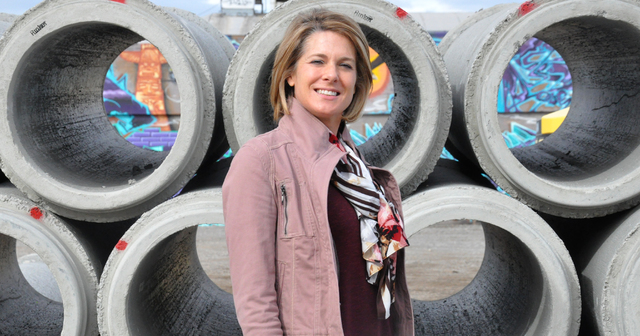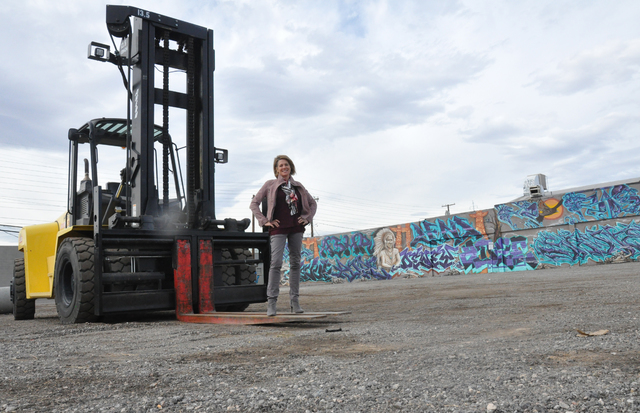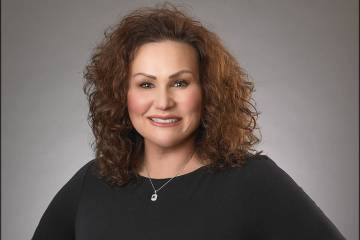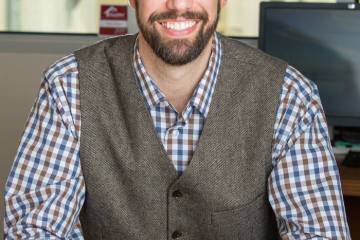


Tina Quigley has served for five years as general manager of the Regional Transportation Commission. The Northern California native majored in Airport Planning and Management and began her career at McCarran International Airport before joining the RTC in 2005.
Q: This city’s population has swelled in recent decades. How challenging has it been to keep up with transportation infrastructure needs?
A: Las Vegas grew very quickly and I remember the former director saying that the minute that a new resort announces that a 3,000 room hotel is going to be breaking ground, we are already five years behind in the process to be able to accommodate those additional rooms.
We had Question Five, which was on the ballot in November, which asked the voters, ‘Do you want to continue tying motor vehicle tax to inflation?’ And we were one of the very few regions in the United States where it did pass.
That is going to allow us to keep up with growth, as we start to see it coming again. It will allow us to continue to maintain the roads, to continue to add safety aspects. Things like flashing crosswalks, improvement to some of our school zones, but also add capacity to roads where we need to. We are very lucky to have that revenue source. In total, over a 10-year period, it is about $3 billion, and that is a really big number in terms of roadway infrastructure.
Q: Many people complain about Las Vegas traffic. Few of those people are from Los Angeles, however. How would you assess our current traffic situation, relative to the realities of urban transportation around the country, and how do we improve it?
A: Just adding asphalt or trying to add green time to traffic lights is not going to fix our problem. We are going to have to move toward two things: more efficient ways of getting around and reducing the number of vehicles that are on our roads. The next thing that I see is the evolution of Uber and Lyft. They talk about how they’re going to get into a mass transit or mass-marketed carpooling type effort. It would collect people where they live and move them to concentrated areas where people work.
If they can do that, and can do it at a rate that is cheaper than driving a car — possibly even be competitive with the cost of a bus fare — now you’re starting to talk about piquing peoples’ interest in carpooling.
If they are successful at that, then you have a chance of reducing the number of vehicles on the road. Other things like a light rail and other mass transit systems that are reliable and efficient and actually get people from where they live to where they work in a timely manner, now you’re starting to talk about (significant progress).
Q: You are talking about fundamentally altering societal culture, in terms of car dependency.
A: Yes, breaking that down. The way you are going that is, the service needs to be attractive to people in terms of reliability, comfort, safety and you need flexibility as well. So if the services can offer all of that, I think you start to create something people will choose to use.
Q: You mentioned light rail. What is the status of that?
A: The most significant conversation we have going on right now is the Maryland Parkway Corridor. It is a north-south corridor with the southernmost point reaching the airport. Connecting the university, Boulevard Mall, the Sunrise Medical district and coming into downtown and connecting the new UNLV medical school. It is kind of an upside-down L shape.
It is currently in the public comment period. The next step would be to incorporate all the public comments, make changes, and then start to go to the federal government to get into a grant program — called the New Starts program — it is a Federal Transit Administration grant program for light rail systems. They would evaluate our proposal and it’s competitiveness with other applications. They can offer up to 50 percent.
Q: And the other 50 percent would be available?
A: Well, we are still sorting that through. It would have a very serious conversation with the community as a whole as to what the funding sources for that would be.
Q: The RTC operates a single traffic management system, which is very unusual for a region with multiple municipalities, and why Audi chose Southern Nevada to test their new interconnective vehicles here. Can you tell us a little about that?
A: We are the very first city in the nation where the new Audi models can share data, so if you’re driving an Audi 2017 model, your dashboard will tell you how many more seconds until the light is going to turn green. It is the very first time that cars and infrastructure are talking together, and it is just going to exponentially accelerate from here.
More models of cars are going to start to have this, and more types of data are going to be able to integrate with the cars. And the cars are going to be able to communicate with each other and the infrastructure so in the end we will become much smarter drivers. Much more aware, and safer drivers. So we should start to see fatalities drop as we become more connected. This Audi test is just the first step toward something much bigger.
Q: Though technology now — particularly smartphones — are partially blamed for an increase in traffic fatalities nationally over the past two years.
A: I think we are in a transitional phase. The world of technology is always going to get ahead of us and it is just going to take some time for society to react — whether it is in terms of policies and regulation — or whether it is in terms of saving ourselves from ourselves.
I think we are probably at that point. If your car can react — not just make you aware, but also tangibly react to its environment — then yeah, you are going to be saving a lot of lives. And we are going to have to continue to struggle with making ourselves responsible drivers, in terms of when it is appropriate to use our devices and when it is not. That is part of learning, I think, for society as a whole.
Q: How will vehicular evolution toward autonomy affect the operations of the RTC?
A: I think it is an absolute game changer in common terms of every aspect of what the RTC does. A local transportation organization agency’s role will demand that they be much more a part of conversations with the private sector, with the software developer and automakers. In the past, automakers did not have to talk to infrastructure providers, but now we are talking about making them one — making it one symbiotic transportation service.
Mobility is a service that requires the infrastructure and the driver’s vehicle to be married. Our role will require collecting and sharing data, and partnering with the private sector as they offer vehicles and services to consumers. We will be collecting data from the vehicles, which will basically be real-time sensors. We can know how traffic — in real time — is operating throughout the valley. Things like when there is an unplanned lane closure, because will be able to see that there is an anomaly in the traffic flow. Any types of anomalies that are happening, we can detect it because these vehicles themselves will be sensors.
I think we will see a lot of smart cars and connectivity, but still have very active drivers long before you will see a society of fully autonomous vehicles. The technology may be there, but we are still humans. And a lot of people will not be comfortable, from the human psychology perspective, with a driverless society.
Q: The RTC recently partnered in the test of an autonomous shuttle, from France-based company Navya, along Fremont Street.
A: It went very well and was popular with riders. It was important to bring in the technology so that people could see, touch, feel — especially our elected officials and business stakeholders. So that they understand exactly where the technology is and where it is headed. It is real, it is coming, but we are a long way away before every vehicle is autonomous.
Q: What is the state of mass transit in the region?
A: There are two types of mass transit services that we offer. One is the fixed route. The buses that stop every quarter of a mile, and some express routes. The paratransit system is our responsibility as well, and that is for people who are either cognitively or physically unable to ride fixed routes. It is a more specialized service.
So in the paratransit arena, we are starting to see transit agencies partner with private sector services like Uber, Lyft and others, because it is very expensive for us to provide that. It cost us about $36 per trip to move somebody on that system, where on our fixed route system it is about $2.20.
Other transit agencies in the United States are experimenting with this right now. Private sector services can do it more efficiently at a reduced cost. So if we partner with them, it is great for taxpayers because we are reducing the tax burden while providing the same service.
Q: Do you believe that private-public partnership is the wave of the future?
A: We are in a transitional, testing phase, so there are several pilot programs going on. We are going to do it here as well, a six-month program with a few different partners, including taxicabs. To see if there is a better way to do it.
It is an extremely burdensome program. It is a great service, because it allows people to live independently that would not be able to otherwise. But it is a very logistically intense service to operate. It is very difficult and very expensive.
Q: How far along is Interstate 11 progress?
A: It is under construction. It is 15 miles and it will be open in spring of 2018. There’s actually a lot of work being done in Arizona. Las Vegas and Phoenix are the only two metropolitan areas in the U.S. not connected by interstate. Phoenix has 80 miles of interstate under construction. So they are doing their portion. Going north of Las Vegas, the Nevada Department of Transportation will be facilitating the next phase of studies. Because there are three alignment they are studying.
Q: What drew you to this field?
A: All of my experience has been in Nevada, in local government and transportation. Between my junior and senior year of college, I did a summer hire program at McCarran International Airport. I thought, ‘This is really great, I get to put this on my resume.’ But I did not want to live in Las Vegas — I just did not feel the connection with the city — and I did not want to be a government employee.
(Laughing) I forgot to read the memo to myself, right? I came back after graduation as a full-time intern at McCarran and ended up really loving it. I ended up loving the city. Actually, it took me a long time. It is an acquired taste. But you get to be exposed to stuff in your career that you would not get exposed to if you were in any other city. It’s a small town in a way, small circles.
I came to the RTC because of Jacob Snow (the former general manager). He was my boss at the airport and a few years after he was here, I had the opportunity to work for him again. And I enjoyed his style of management. I love the team of people I work with, and that makes a big difference. People who are super smart and passionate. There is something very deeply fulfilling about that, and also the scope of the work itself. You get to feel like you are leaving a mark. It is really cool.






